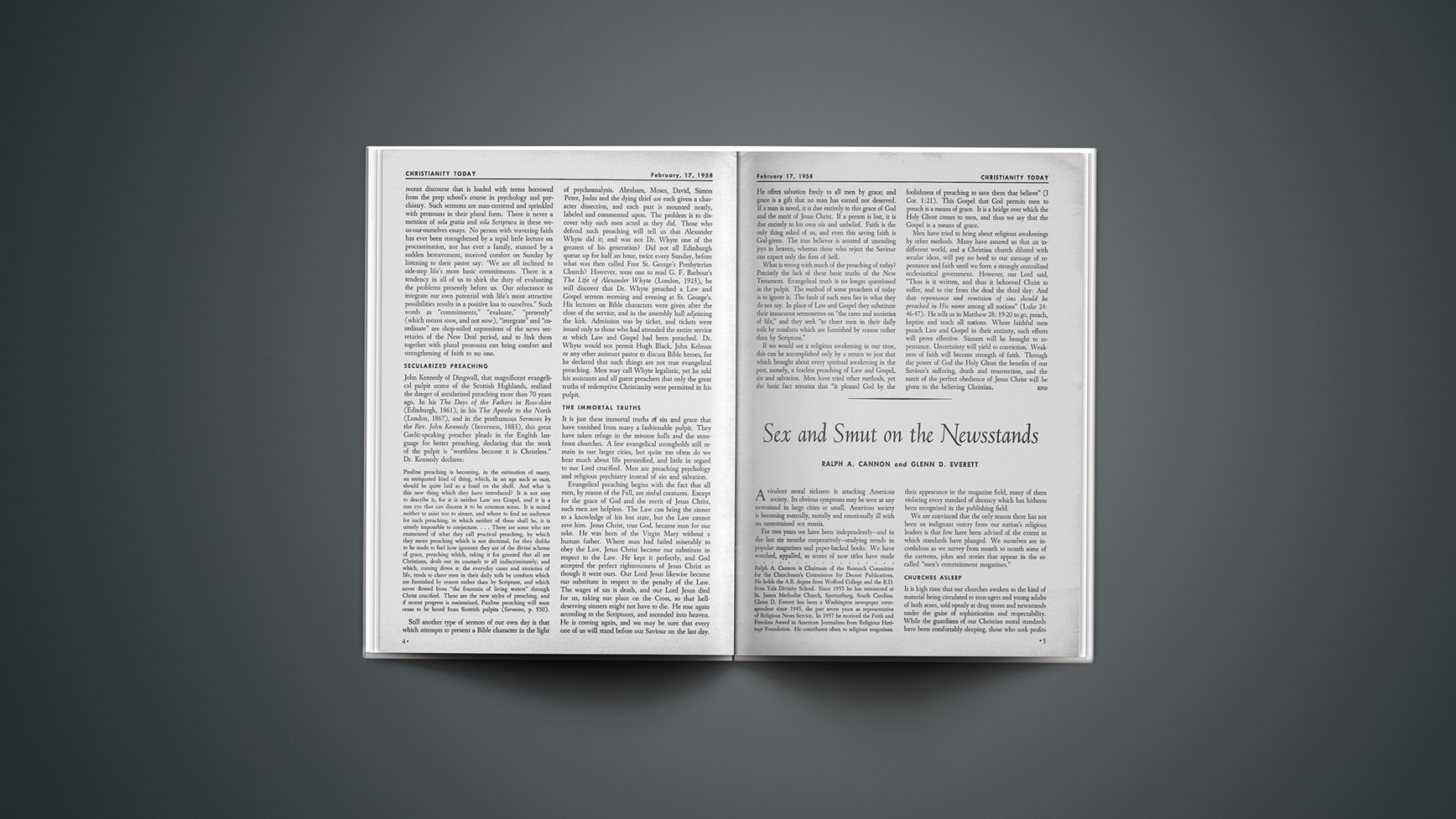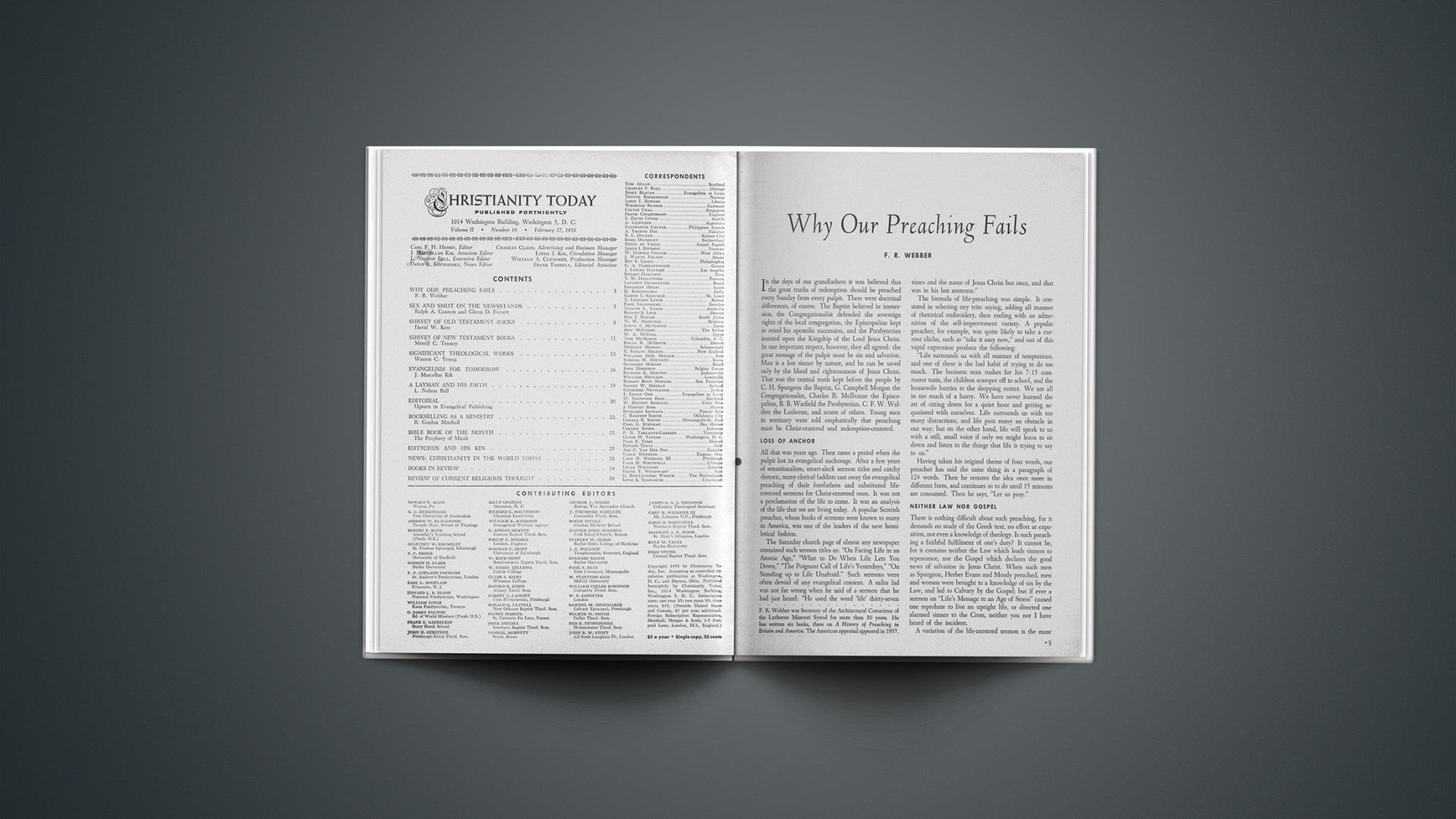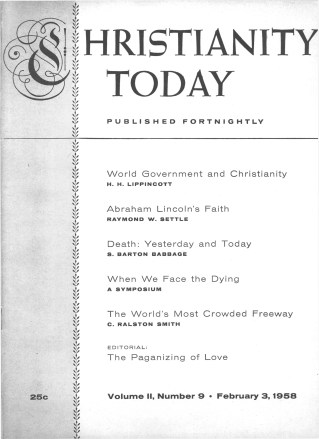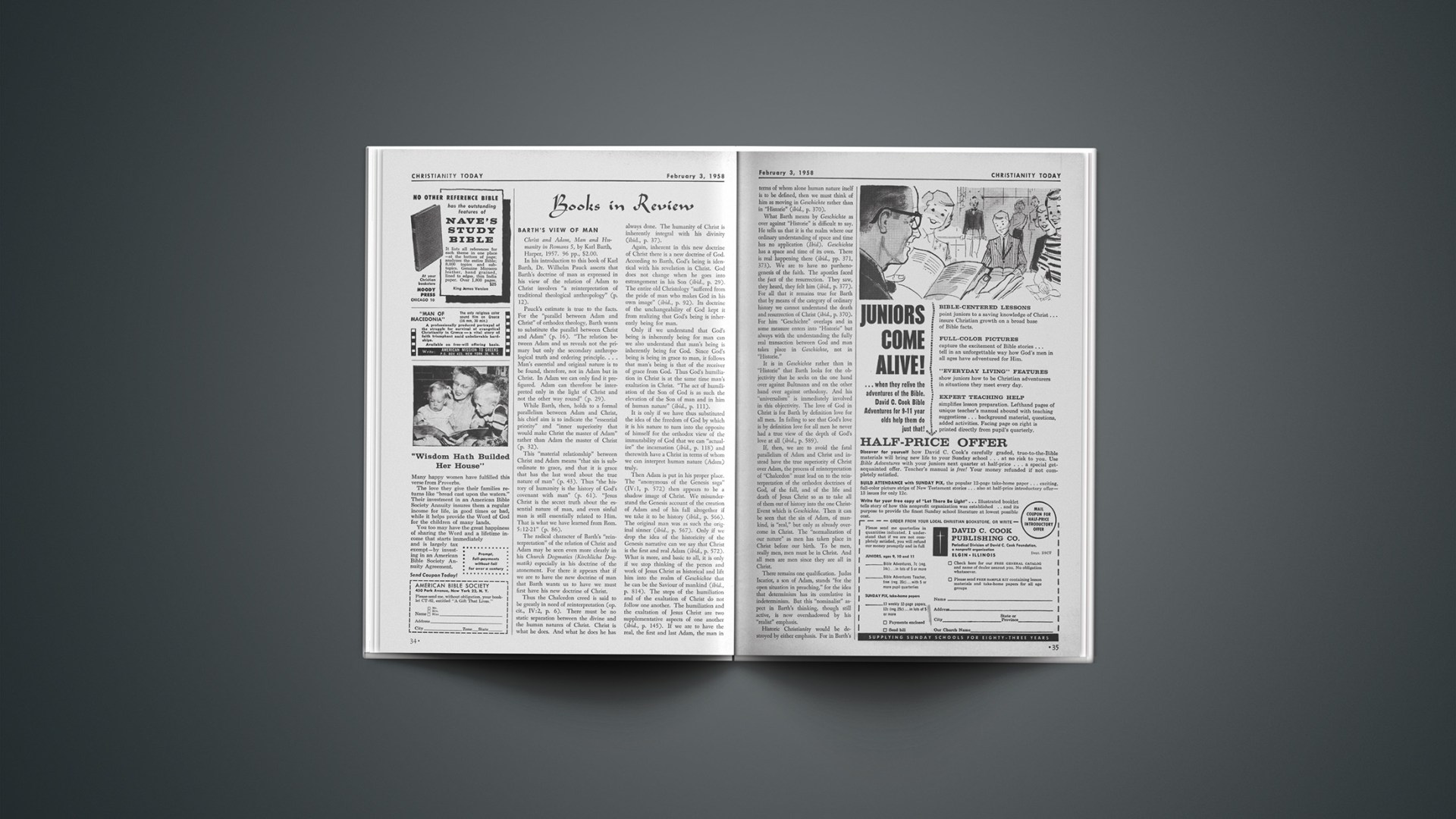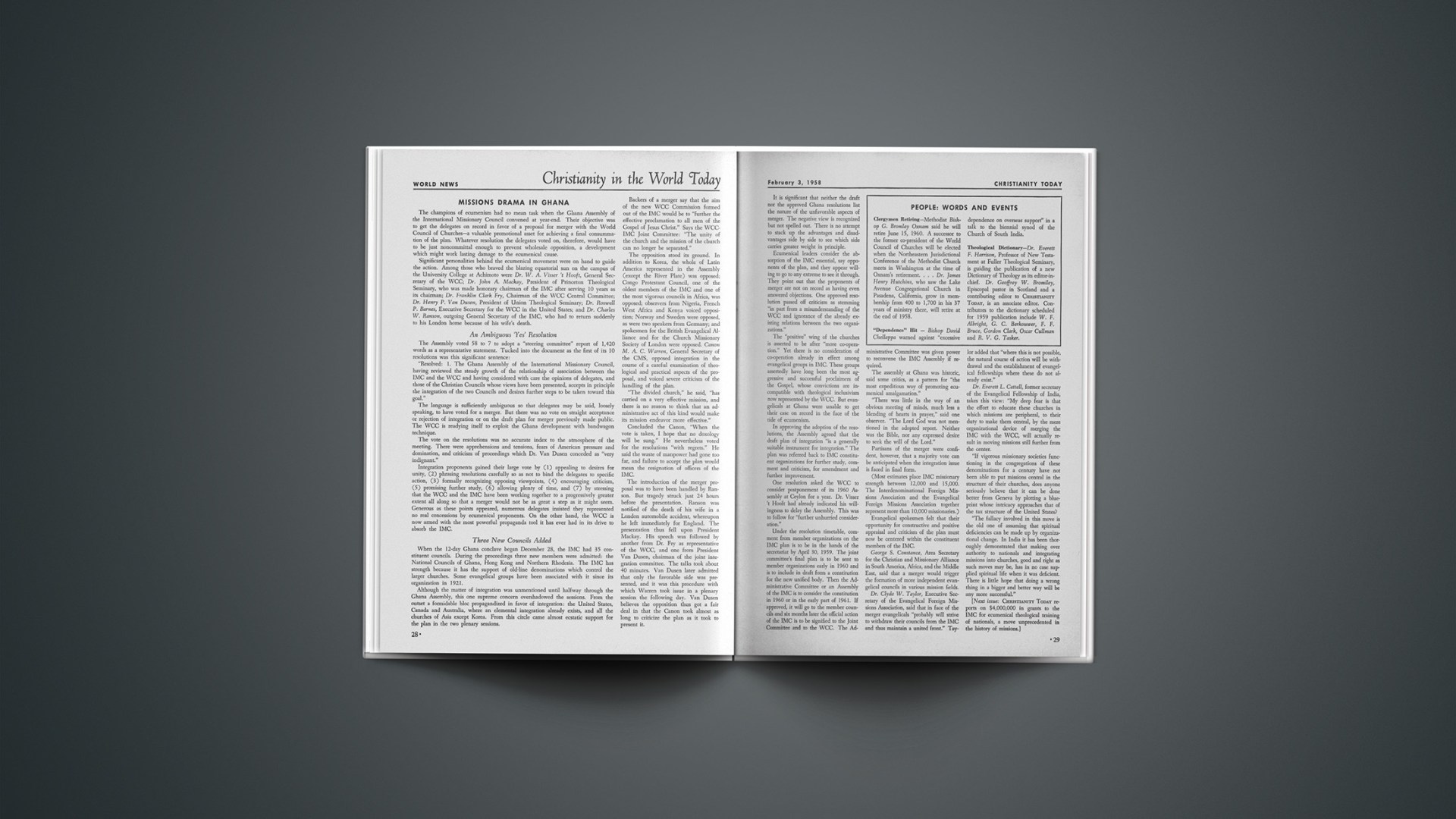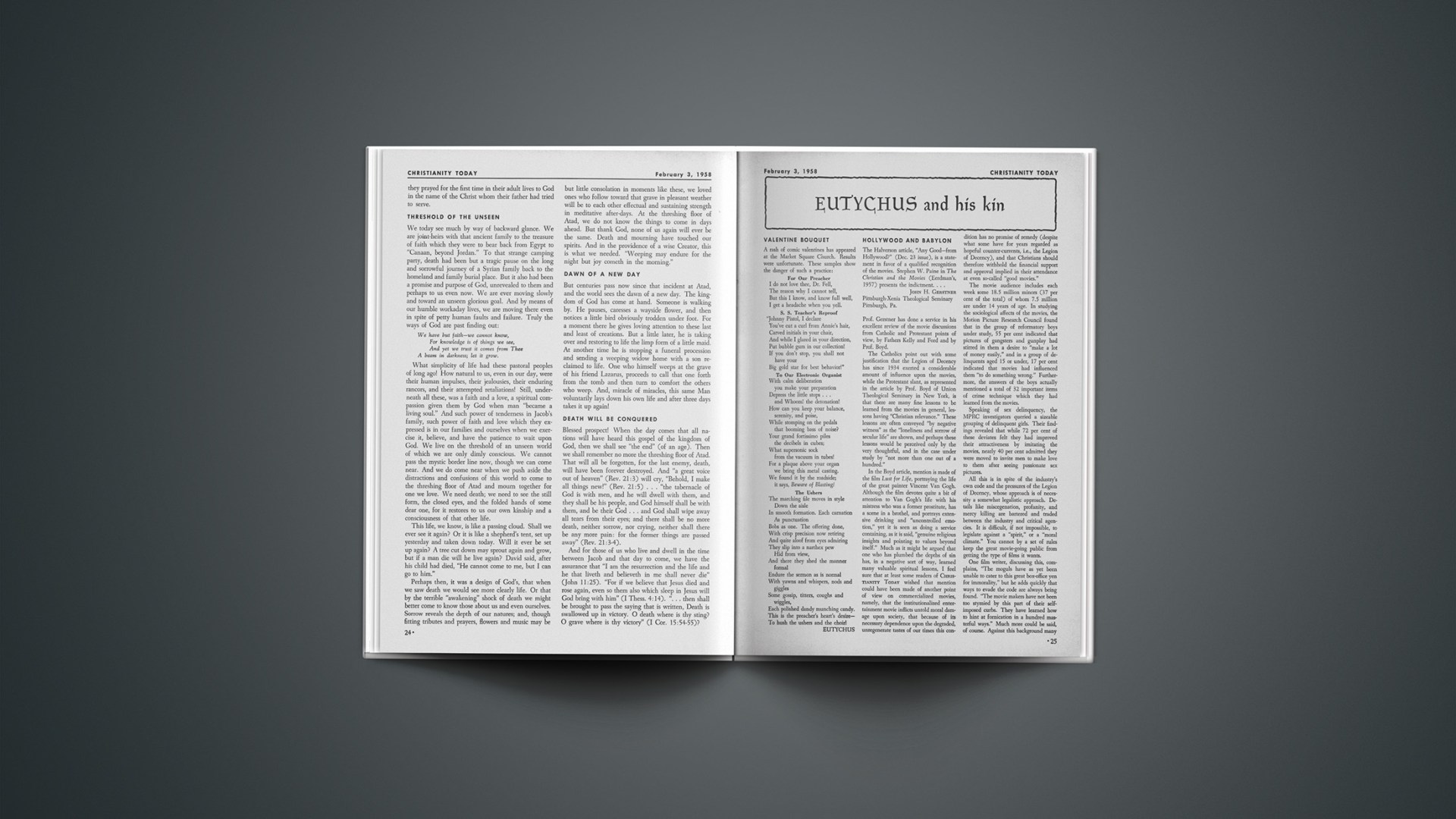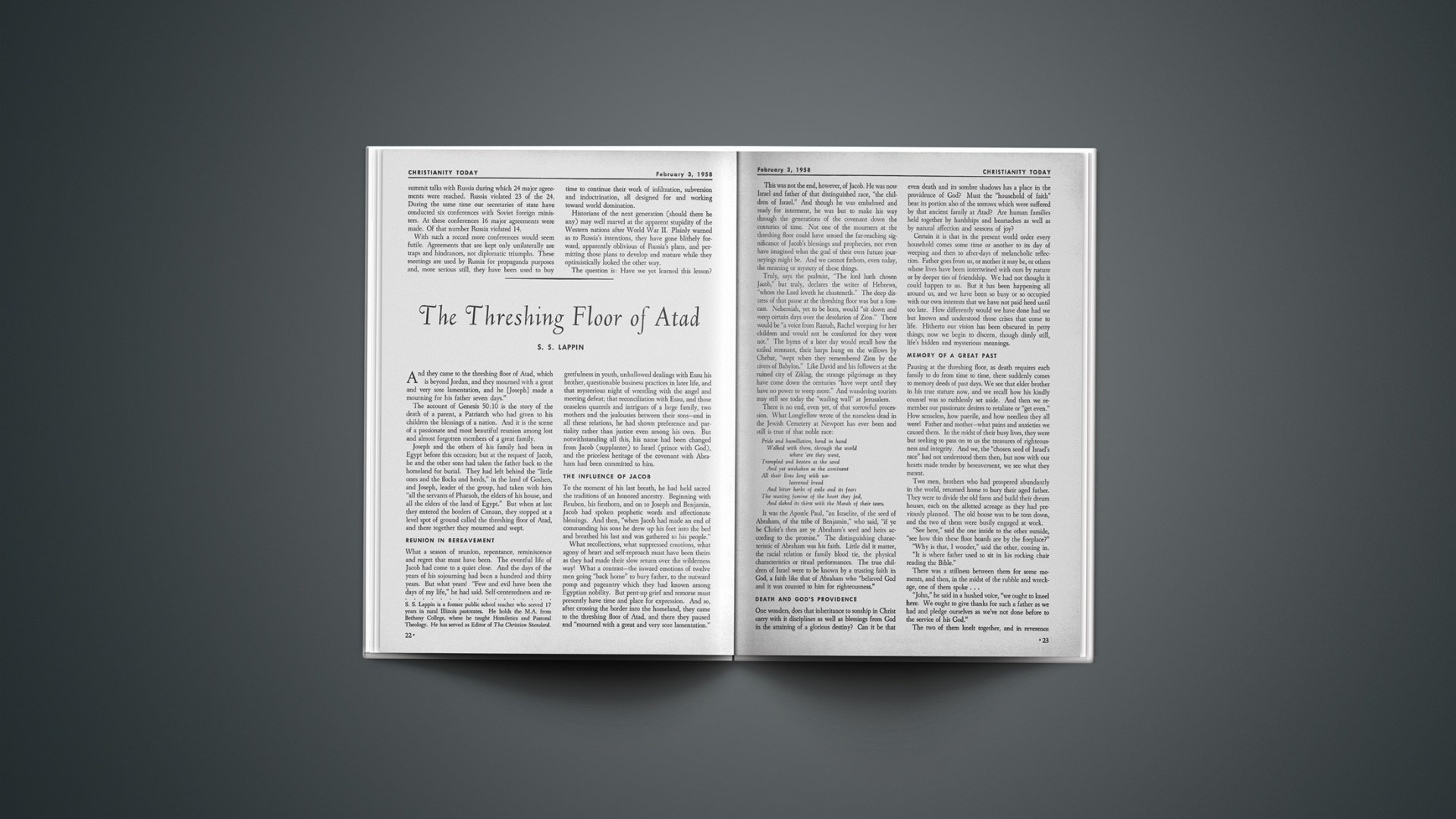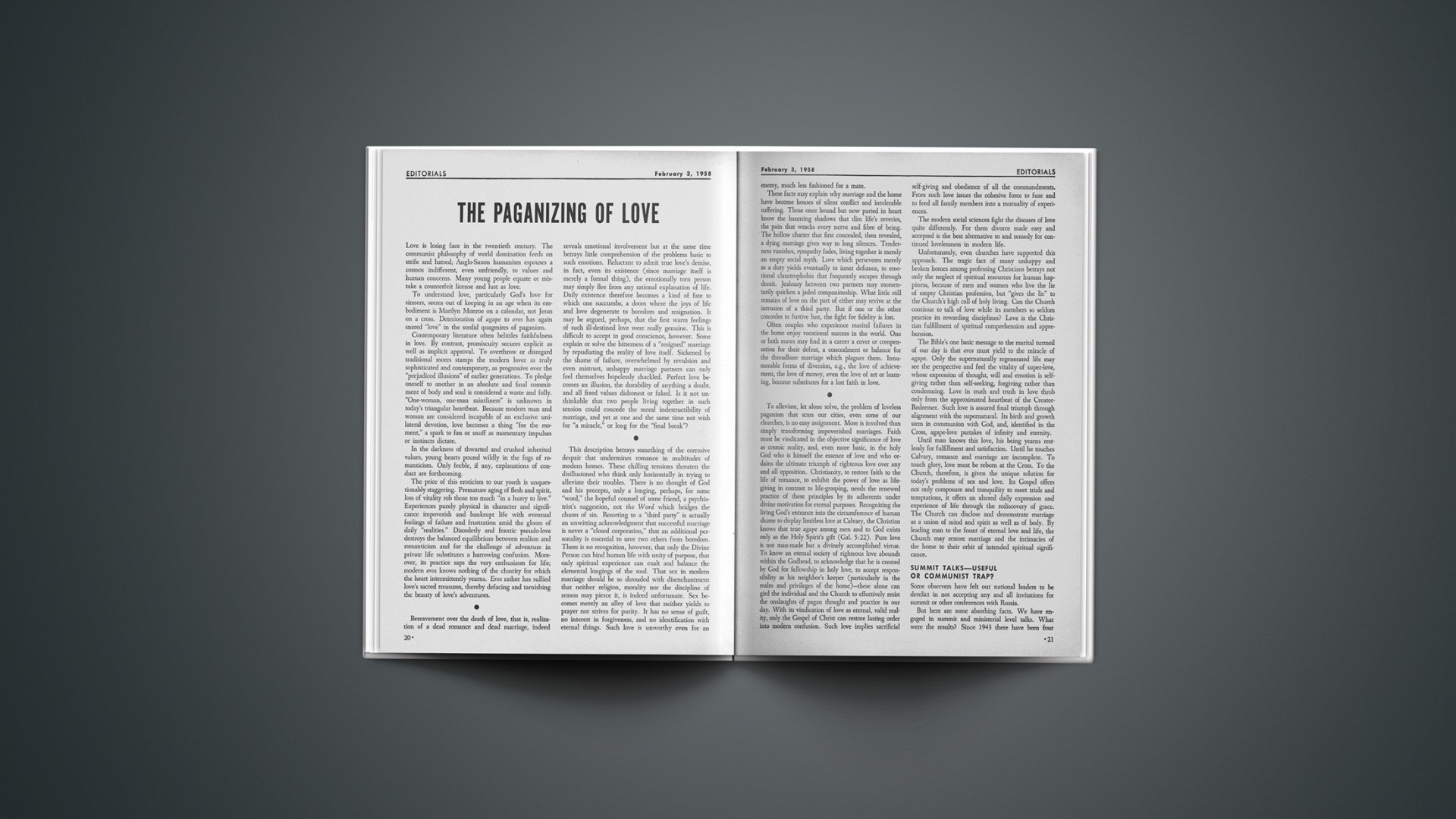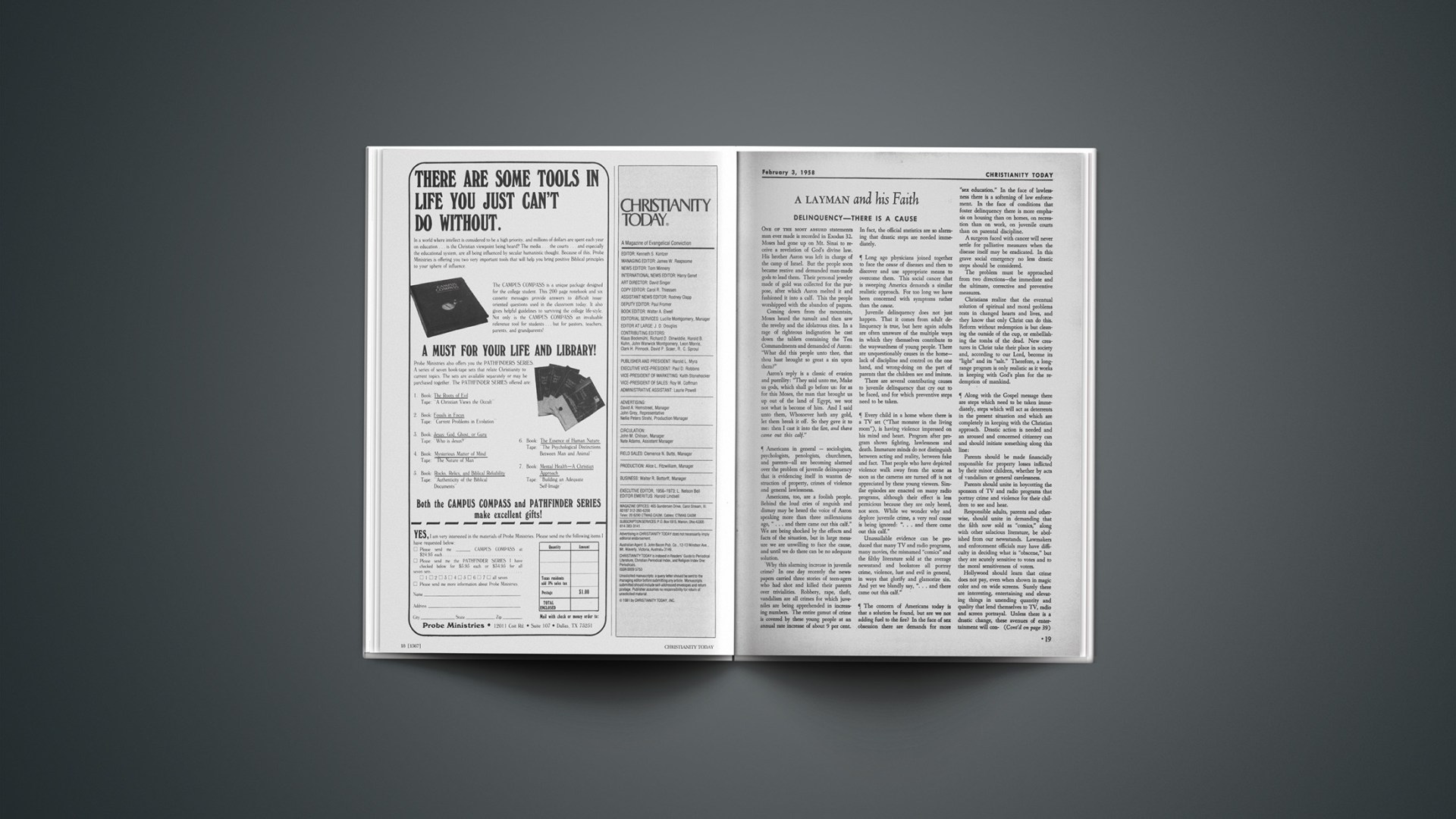A virulent moral sickness is attacking American society. Its obvious symptoms may be seen at any newsstand in large cities or small. American society is becoming mentally, morally and emotionally ill with an unrestrained sex mania.
For two years we have been independently—and in the last six months cooperatively—studying trends in popular magazines and paper-backed books. We have watched, appalled, as scores of new titles have made their appearance in the magazine field, many of them violating every standard of decency which has hitherto been recognized in the publishing field.
We are convinced that the only reason there has not been an indignant outcry from our nation’s religious leaders is that few have been advised of the extent to which standards have plunged. We ourselves are incredulous as we survey from month to month some of the cartoons, jokes and stories that appear in the so-called “men’s entertainment magazines.”
Churches Asleep
It is high time that our churches awaken to the kind of material being circulated to teen-agers and young adults of both sexes, sold openly at drug stores and newsstands under the guise of sophistication and respectability. While the guardians of our Christian moral standards have been comfortably sleeping, those who seek profits by pandering to sensuality and lawlessness have been reaping a golden harvest.
Distasteful and unpleasant as the subject of pornography may be, it is one that imperatively calls for the attention of every churchman in our nation who is concerned with preserving the sanctity of the Christian home as the basic unit of American society.
The expose magazines like Confidential, and its imitators, Whisper, Hush-Hush and Uncensored, enjoy circulations running into the millions. Using the language of the gutter and the names of celebrities whose marital misadventures they exploit, they are spreading the cynical philosophy “Everybody’s doing it!” to millions of impressionable young people.
The so-called “men’s entertainment magazines,” led by Playboy, and its imitators, Nugget, Dude, Bachelor, Gent and Modern Man, hide behind covers of innocuous, sophisticated design, while they peddle article after article glorifying prostitution, sadism, orgies and sexual perversion.
The “girlie” magazines, such as Night and Day, Paris Life, Tab, Pin-Up Art and literally scores of others, go farther each issue in portraying nudity than has ever been the case before. More important, the models are posed in a languorous manner calculated to be as suggestive as possible. It is difficult to stay within the bounds of good taste and convey to the decent citizen who rarely peruses such periodicals and almost never reads the stories, the extent of the depravity to which they have sunk. The current February issue of Playboy which can be obtained from almost any newsstand can serve as a typical example. The language of the gutter is flaunted with a sneer and detailed descriptions of the most sordid acts of fornication are given on almost every page.
These magazines are known to the high school crowd across America, so the mention of the likes is not unwise; it is the ministers of America who are unaware of them, and ministerial meetings and councils that must be put on the alert for swift action.
Openly Anti-Christian
The immorality of such magazines does not lie simply in the fact that there is too much unadorned flesh and an excessive use of indecent language, but rather in the over-all attitude toward sex represented by such publications. The philosophy of these magazines is not just amoral. It is openly and avowedly anti-Christian.
Sex is depicted as a merely biological, animalistic function in the same category as eating and breathing. Women are completely de-personalized and are shown merely as pliant machines which men utilize for brutish pleasure. We have read hundreds of stories in these magazines and in not one has the heroine ever been depicted as having the slightest moral objection to seduction. If the man does not achieve his lustful purpose, it is only because his technique is not right. The typical woman who populates these publications is herself a nymphomaniac whose entire existence and nature is tied up in one prolonged, unbearable, insatiable desire to perform the sex act.
Anyone who puts any stock in virtue, chastity, fidelity or restraint is ridiculed. They are depicted as victims of outmoded hypocritical prudery. To have any scruples about free erotic indulgence is to be neurotically repressed. These magazines are advocating a pagan, libertine philosophy of life directly opposed to the Christian concept of love and marriage. It has become in the last 12 months the most sustained and insidious attack on the moral standards of this nation ever witnessed in the history of our Republic.
A certain pattern runs through the fiction offered in all these periodicals. One theme is to depict religious persons as fanatics and hypocrites. One magazine recently published a story about a Southern Baptist clergyman who in the process of “saving” a sister from her frustrations, “redeemed” her by commiting adultery with her. The writer of this obscenity and blasphemy took care to make his subject a Protestant minister and not a Roman Catholic priest, for that church would surely have moved in massive protest.
Another theme is the glorification of prostitution. It is depicted not as a degraded, back-street crime, but as something that smart girls of the upper middle class do. Bachelor, a magazine obviously aimed at college students in pictures, cartoons and text recently published a story “The Girls in Dormitory A” which told of co-eds who ran a house of ill fame on the night their housemother was out. She caught them, as inevitably she must, but her reaction was to turn it into a real “business operation” open every night.
We also see recurring in cartoons and stories the theme of the wife who prostitutes herself to her husband’s employer so that he can obtain a raise or a promotion to branch manager. Playboy has even gone so far as to make a cartoon jest about incest. Nothing is too degraded for these magazines to touch, for under the libertine standard which they espouse, any restraint on sex relationships is puritanical repression from which “modern man” should be liberated.
Contempt For Religion
The attitude of contempt in which these publications hold religion is illustrated by attacks on Evangelist Billy Graham in the January issue of Rave and the March issue of Foto-Rama, both now on newsstands.
Rave depicts Graham on its cover as a huckster offering a hot breakfast cereal labeled “Instant Salvation.” The story, entitled “How to Sell GOD” bears the subtide “Billy Graham, the Hotshot of the Hucksters, Is Delivering a Packaged Heaven to All who Heed the Call.” The article accordingly declares, “Something new has been added to the fiery-eyed procession of doom merchants.” After paying respects to Jeremiah as “scary-looking,” Savanarola as “scrawny and scowling,” and Billy Sunday as a “baggy-kneed solo artist,” the writer bitingly ridicules Graham’s neat appearance and smooth sermon delivery.
A photograph of Graham talking to President Eisenhower carries the caption “Billy and Ike—Anybody Who Doesn’t Like What he Gives Them can go to Hell.” Rave, which in some respects appears to be an aptly-named magazine, summarizes its opinion of Graham’s ministry as “road-show Christianity—superficial, sentimentalized, sold by the best Fuller Brush man in North Carolina … a product that will oh-so-easily make you five shades whiter.”
Foto-Rama, by contrast, treats Graham with a mocking reverence. It seems engaged simply in exploiting Graham’s name for the sake of a superficial respectability—perhaps in order to include at least one article which counsel can quote if the publication is prosecuted for obscenity. The cover of Foto-Rama carries a large caption: “In Sex: Does Practice Make Good Lovers?” Underneath appears the headline “What Billy Graham Thinks of Girls.” The first article, of course, is one advocating “more liberal sex education” in schools.
In the article on Graham, the magazine gives passing notice to the evangelist’s emphasis on the Christian home as the foundation of American society, then spends most of the space discussing the business side of his crusades. The article concludes a largely critical and cynical account of his work with the pious observation: “Foto-Rama salutes Billy Graham for the splendid work he is doing in bringing religion into American lives.”
Foto-Rama then gets on with what it obviously conceives to be its business—to bring into American lives such articles as “How the Strippers Took Paree”; a near-nude photo sequence entitled “S is for Sizzle”; and an expose-type article “Why Do Men Throw Stag Parties?,” subtitled “There Were Thirty Men Standing When the Naked Corinne Went Through the Motions.” These stories, together with the inevitable article appealing to sadism, a sordid, depraved tale of alleged cannibalism during World War II entitled “I Ate My Buddy!” would seem to constitute the real mission of Foto-Rama in American life. We might add, in passing, that a disturbing number of articles appealing to sadism appear in recent issues of the sex magazines. Sadism is the most vicious of all sex perversions, since it leads to horrible sex crimes and is a factor in the break-up of many marriages. Yet these magazines, in their lust for the dollar, do not hesitate to pander even to this base instinct of depraved men.
We must voice a most urgent call to our Protestant churches to join in a vigorous campaign to re-establish common standards of decency in publishing.
The United States Supreme Court in the case of Roth v. U. S. last June gave us a workable legal definition of obscenity. It is, to quote the Court, “The presentation of sex in a manner appealing to the prurient interest.” The Court added the caution that it must be judged in the light of “contemporary community standards.”
The Court made it clear that obscenity has no standing under freedom of the press. The way is open, therefore, for use of the courts to prosecute those newsstand dealers, and those wholesale distributors, who bring sex magazines into a community if they fail to heed appeals for a voluntary clean-up.
Churchmen’S Commission
An organization to co-ordinate Protestant efforts in this field has recently been established known as the Churchmen’s Commission for Decent Publications. Membership is open to any Protestant layman or minister concerned with this problem. Its membership includes a more broadly representative group of Protestantism than any group ever brought together. Inman Douglass of the Committee on Publication of the Christian Science Church is the Commission’s first president; Frederick E. Reissig of the Council of Churches, National Capital Area, vice president; Dr. Clyde W. Taylor, of the National Association of Evangelicals, secretary; Editor Carl F. H. Henry of CHRISTIANITY TODAY, treasurer. Mr. O. K. Armstrong, contributing editor of Reader’s Digest and Southern Baptist layman, is legislative chairman.
The very word “censorship” is repugnant to Protestant leaders. The alternative to Protestant inactivity in this field, however, is to leave it by default entirely to Roman Catholic groups. Inevitably, their approach to the issue differs greatly from the Protestant position. Wherever there is strong Catholic-inspired legislation against indecent literature, as in the Province of Quebec, for example, we soon find such things as the movie “Martin Luther” being banned also because it would “disturb the public order.”
Censorship, in the sense of establishing a board of public censors whose approval must be obtained before a book or magazine may be published or a movie exhibited is clearly repugnant to the American tradition and to the U. S. Constitution itself. The Churchmen’s Commission, therefore, favors efforts to obtain voluntary co-operation in securing compliance with community standards. Where this fails, the question of “obscenity” in the light of prevailing community standards should be decided by local judges and juries.
We have laws against dope peddlers and against those who would promote the practice of prostitution. We similarly have laws against those who would subvert the basic foundations of society by assailing its moral standards. All that is needed is for existing laws to be enforced in light of the Supreme Court’s workable and intelligent definition of “obscenity.” Public opinion must be mobilized to do the job. Most of these magazines do not have a leg on which to stand if they are brought into court.
We frankly appeal to churchmen and churchwomen of every persuasion, conservative or liberal, to join hands in common defense of the morals of our society. An assault has been mounted against everything Jesus Christ, Paul and the Apostles taught concerning love, marriage and the family. If our churches fail to answer it, they will rue the day that their timidity and inaction gave a victory, by default, to the advocates of paganism.
(Address of the Churchman’s Commission on Decent Publications is Suite 100, Western Union Building, 1405 G Street, N.W., Washington 5, D. C. The research and action reports which it publishes will be of great help in organizing local drives to clean up newsstands and to keep them clean—ED.)
Ralph A. Cannon is Chairman of the Research Committee for the Churchmen’s Commission for Decent Publications. He holds the A.B. degree from Wofford College and the B.D. from Yale Divinity School. Since 1955 he has ministered at St. James Methodist Church, Spartanburg, South Carolina.

